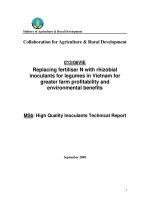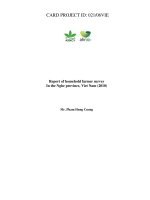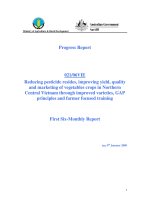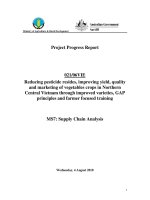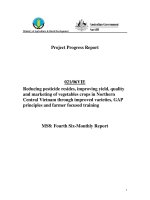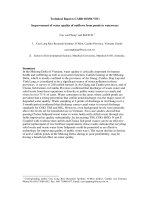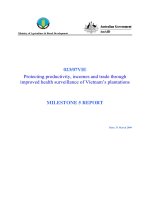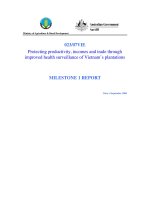Báo cáo khoa học nông nghiệp " IMPROVEMENT OF DOMESTIC AND EXPORT MARKETS FOR VIETNAMESE FRUIT THROUGH IMPROVED POSTHARVEST AND SUPPLY CHAIN MANAGEMENT " pptx
Bạn đang xem bản rút gọn của tài liệu. Xem và tải ngay bản đầy đủ của tài liệu tại đây (368.44 KB, 12 trang )
GAP Workshop in Binh Thuan (21-22/7/2008)
1
IMPROVEMENT OF DOMESTIC AND EXPORT MARKETS
FOR VIETNAMESE FRUIT THROUGH IMPROVED POST-
HARVEST AND SUPPLY CHAIN MANAGEMENT
Mr. R. J. Nissen
1
, Mr. Nguyen Duy. Duc
2,
. Dr. Nguyen Minh .Chau .
3
, Mr. Vu Cong.Khanh
2
, Mr Ngo Van Binh
2
, Ms
San Tram Anh
2
, Ms Tran Thi Kim Oanh
2
1
Department of Primary Industries and Fisheries, Maroochy Research Station, PO Box 5083, Sunshine Coast Mail
Centre, Nambour, Queensland, 4560, Australia.
2
Southern Sub-Institute of Agricultural Engineering and Post-Harvest Technology, 54 Tran Khanh Du Street,
District 1, Ho Chi Minh City, Vietnam.
3
Southern Fruit Research Institute, Long Dinh-Chau Thanh, Tien Giang. Vietnam.
Abstract
The fruit industry in Vietnam has a great potential and plays an important role in agricultural
production. About 85% of Vietnamese households are involved in some way in vegetable, fruit
and flower production. These people, especially the farmers, are experiencing dramatic changes
in moving from a centrally-planned to a market-orientated economy (Nguyen Dinh Hung, et al.,
2004). Exports of fruit and vegetables in 2000 were US$213 million, in 2003 they fell to $151
million, but in 2007 exports have now risen to 283 million (Vietnam News 2007). Vietnam is
experiencing difficulties in competing with other Asian nations in export markets and its own
domestic market, especially with China and Thailand. This suggests that Vietnam’s horticultural
industries require substantial development to be globally and domestically competitive. With
increasing living standards Vietnamese consumers are also demanding safer and higher quality
fruit. This CARD project mapped current domestic supply chains to determine customer and
consumers preferences and needs. This information was then used to design training programs
that focusing on the total supply chain to implement quality management and Good Agricultural
Practices (GAP) systems that provide benefits to Vietnamese farmer, supply chain participants
and ultimately the consumer. To date about 572 farmers, 79 collectors and wholesalers have had
training by this CARD project in pre-and post-harvest GAP practices.
Introduction
Globally, consumer concerns on food safety and product quality has led to implementation of
new food safety systems, but implementing new quality assurance systems is resource
demanding, time consuming and expensive for farmers. Farmers in Vietnam are trying to meet
food safety and quality guidelines imposed by large national and international retail corporations
and companies to remain profitable. Many major retailers have implemented their own quality
assurance and product standards leading many farmers, collectors, traders and exporters to
believe that this is a means of excluding them from accessing higher value markets. Compared
with developed countries, supply chains of Vietnam are longer and often include twice as many
participants and are based on traditional practices which are not easily changed.
Fruit and Vegetable crops are highly lucrative compared to staple crops. Horticultural produce
has high value-added and income generation potential when compared to livestock and grain
production. Horticulture is highly attractive especially for small scale farmers, and has a
comparative advantage, particularly where land holdings are small, labour is abundant and
markets reasonably accessible (Weinberger and Lumpkin, 2006). This situation is particularly
true in Mekong Delta and Central South Cost Province of Khanh Hoa, Vietnam. Ford et al.,
(2003), suggested that the competitiveness of Vietnamese fruit industries was poor due to:-
• unstable product quality and no quality standards
• poor post harvest technologies and pre-harvest practices
• lack of group co-operative marketing structures
GAP Workshop in Binh Thuan (21-22/7/2008)
2
• little information about supply chains, prices and customers needs.
In this CARD project we have addressed these issues by:
• Mapping of current domestic supply chains with particular emphasis on determining
consumer preferences and needs, and reporting results back to farmers and other chain
participants.
• Providing a better understanding and highlighting possible improvements that can be made
by Vietnamese farmers and chain participants for the selected mango and pomelo
industries.
• Highly targeted training programs that have been carried out for institutes, supply chain
participants and farmers.
• Providing training in pre-and post-harvest technologies to improve fruit quality based on
GAP principles of integrated pest, disease, orchard management and product management,
maturity indices, to improve environmental and human health in the production and eating
of the produce.
• Improving quality standards and quality assurance programs for mango and pomelo.
• Improving mango and pomelo post-harvest technologies to reduce quality loss through new
packaging methods, post harvest dipping, washing and sanitising and quality assurance.
Although Vietnamese horticultural farmers do benefit from improved yields, their primary
interest has been to make a reasonable living from their farm, and to be environmentally and
economically sustainable. Farmers seldom adopt fully, the technology packages developed for
them. On the other hand, they frequently adopt what they consider are key elements or building
blocks, that they put together to suit their particular needs; “they adapt rather than adopt” (Horne
and Stür, 2003). The extension and training processes we are using are based on adult learning
processes and participatory action learning (PAL) (Horne and Stür, 2003), train the trainer (TTT)
and participant training participant (PTP).
A chain must provide a clear process to handle change, minimise risk, share rewards and
deliver transparency through effective communication and knowledge sharing (Collins, 2003;
Batt, et al., 2005). PAL and PTP are some of the underling principal practices used to obtain an
understanding of the culture, to develop trust and rapport, to be consultative and to obtain supply
chain participant input (Collins, 2003; Kolb, 1984).
Methodology
New processes have been developed by this CARD project to assist farmers, collectors,
wholesalers, traders, retailers, extension agents and researchers to implement improved
horticultural supply chain practices based on GAP principles for Vietnam. The approaches which
we are using to build new or improve existing supply chains and to develop their social and
evaluation skills so they will become more responsive to customer requirements. The skills that
we are attempting to transfer are related to two key areas (Nissen et al, 2007). These are:
1. personnel relationship skills to maintain and develop a GAP supply chain
2. strategic planning process to develop or modify a supply chain including GAP systems
approach
Relationship development
To help ensure sustainability and adoption of the GAP systems a new process was developed
and used by chain participants (farmers, collectors, wholesalers, traders, retailers and the
Vietnamese institutions involved). This process is based on an active decision making by the
chain participants. See Figure 1 for graphic representation of this process.
Chain strategic planning and development
This process involves:-
Step 1
. Define and clarify. To develop a supply chain to reach target markets, agreements
must be reached with chain participants on the mission, aims and objective.
GAP Workshop in Binh Thuan (21-22/7/2008)
3
Step 2. Information gathering. Information is collected, by segmenting the supply chain using
priority components for problem analysis La Gra (1990). See Figure 2 for graphical
representation of supply chain segmentation.
Processes used to gather information are:- interviews, observational surveys, surveys using
sequential sampling, and process analysis at critical points along the chain.
Step 3
. Compile and summarise information gathered. Organise information gathered into
product, information and monetary flows, infrastructure and skills audit and identification of
chain champions at each segment along the chain. Indicate where GAP is used.
Step 4
. Analysis of the information. SWOT analysis and AFFA supply chain analysis that
focuses on consumers, creating shared value, getting the product right, effective logistics and
distribution, effective information and communication, and effective relationships and where
GAP can be introduced and improved.
Step 5
. Develop new supply chains.
Part a). Define the most appropriate supply chain to achieve the supply chain objective, aims
and mission. Identify GAP requirements for product, information and monetary flows, product
quality assurance, infrastructure and skills development for the chain.
Part b). Fine-tune the supply chain using processes such as:
• test of supply chain fit
• start to end focus of the chain
• Simplicity test on the chain
• Integrity test on the chain
Part c). Identify areas for improvement using GAP analysis: this should be carried out for the
product, using La Gra chain segmentation. This should also include GAP analysis of:
• Knowledge/skills
• Infrastructure/facilities/resources
• Relationships
Part d). List the improvements in order of importance
Step 6. Develop action plans.
Part a). What GAP processes need to be done/provided to implement improvements?
• Product, information and monetary flows
• Knowledge/skills
• Infrastructure/facilities/resources
• Relationships
Part b). Develop action plans for:
• What is to be done
• How is it to be done
• Who is responsible
• When will it be done
Step 7. Evaluate the performance of the new supply chain. Evaluate the supply chain by
monitoring key performance indicators (KPI’s), based on GAP, conduct sampling, auditing
and undertake process analysis to determine how effective if the chain is at achieving the aims
and objectives set out in Step 1.
Results and Findings
The Australian team devised the processes presented above in the methodology section based
on GAP systems to train Vietnamese’s institution staff (SIAEP and SOFRI), Vietnamese pomelo
and mango farmers, collectors, wholesalers, traders, and retailers. These were used to develop
new and improved supply chains for delivery of higher quality safe fruit to their Vietnamese
customers. The strategic plan priorities for mango and pomelo chains are shown below in Table
1 and 2. These were developed by mango and pomelo farmers, collectors, wholesalers, traders
and retailers with extension and research officers of Southern Sub-Institute of Agricultural
GAP Workshop in Binh Thuan (21-22/7/2008)
4
Engineering and Post-Harvest Technology (SIAEP) and Southern Fruit Research Institute via the
strategic planning process.
Supply chain mapping and practices
Determining the wants and needs target market customers has to been conducted by this
CARD supply chain project. This project conducted surveys of mango consumers, retailers,
wholesalers, collectors and farmers to develop improved and new supply chains.
Consumers:-
The mango variety ‘Cat Hoa Loc’ was the most popular variety with consumers;
71.43% prefer to purchase and eat this variety, due to its attractive colour, flavour and perceived
market prestige. About 76% of consumers purchased from one to three kg of fruit, four to eight
times per month. Most consumers purchased from retail markets because they were easy to
access, they are able to select individual fruit and had established long-term standing
relationships with the vendor. About 51.7% of consumers indicated they had problems when
selecting mangoes to purchase due to uneven ripening.
Retailers:-
Many retailers experienced difficulties in obtaining good fruit. About 45% of all
retailers indicated that their purchases did not meet the agreed terms. Agreements were broken
on price, quantity and product quality. About 15% of retailers indicated that fruit size was not
uniform as per the agreement. Stem-end rot and anthracnose are the biggest causes of fruit loss
during storage and sale.
Wholesalers:-
Major problems faced by wholesalers when purchasing mangoes were; 1) 45%
of sellers did not follow the agreed price quantity and quality; 2) 5% did not deliver uniform
size; 3) 10% distance and transport problems; 4) 40% combination of many small factors. When
selling fruit, major problems faced by wholesalers were; 1) 100% indicated price fluctuations
were a major concern especially when markets are saturated; 2) 10% indicated that distance to
transport the crop was a major problem; 3) a further 10% indicated that purchases did not follow
agreements on price quantity and quality; 4) and 10% indicated that market taxes were to high.
Fruit losses were high because, rotting and shrivelling fruit or ugly fruit, are not removed.
Purchase weight loss occurs, due to fruit moisture loss and attacks by mice, rats, ants if the fruit
are stored for several days.
Collectors:-
Collectors do not want fruit that is ripe but hard green. Depending upon district,
between 50%-100% of collectors will grade fruit. Collector places of trade are usually their
house. Reasons collectors’ grade fruit are; 1) to return baskets to growers; 2) ensure no ripe fruit
is in the consignments; 3) ensure their business and reputation for delivering the fruit quality
promised to their customers. Most collectors pack fruit into 30-50 kilograms bamboo baskets.
They use two types of bamboo baskets. One basket is made from bamboo woven into a strong
inflexible basket. The other is constructed from type of thin, softer, woven bamboo mat.
Farmers:- Both
collectors and farmers prefer to sell mixed grades, even though the farm gate
price will be low. This is done to allow farmers to sell Class 3 fruit which is not easy to sell.
Many collectors/wholesalers find it extremely difficult to sell Class 3 fruit. This adds significant
costs to all aspects of the supply chain and affects farmer returns. About 58% of farmers sell
reject fruit at the local market while a further 20% will sell to home consumers. All farmers use
pesticides. Pesticide sellers’ recommendations have increased farmer’s spray load significantly
from 26 to 37 sprays per year, whereas the number of insecticide products used per farmer
increased from 2.6 to 3.9 with advice from extension staff and media. Only 10% of the 93
participating farmers knew about natural enemies for pests, all of which were predators. Around
20% of the insecticides used belonged to WHO Toxicity Class I, while nearly all the rest
belonged to Class II (Van Mele et al., 2001).
Chain practices:
- Traditional mango supply chains in southern Vietnam are long in terms of
number of participants and number of times fruit are handled compared to developed countries.
No fruit class and quality standards exist for many of the supply chains. Opportunistic
marketing practices by collectors and wholesalers are evident (Quinn et al., 2006). Verbal
agreements between chain participants are not strictly enforced or adhered to. Topping is a
common practice, where by better quality fruit in each grade are placed on top of each basket.
GAP Workshop in Binh Thuan (21-22/7/2008)
5
Very little or no cool chain practices are carried out. Top layers of high quality, extra class fruit
and class 1 fruit are wrapped in paper with stalks attached. This is done to reassure customers
that the fruit they are about to purchase are fresh. These stalks often break off during handling
and transport and sap burn of the fruit results. After studying the mango supply chain, farmer
estimates of damaged fruit at the wholesale market is from 25 to 40%. Surveys found that on
average 31% of fruit suffer from sap burn and fruit rots. Quality monitoring surveys to establish
fruit defects have been carried out on mango by SOFRI staff. Fruit affected by sapburn ranged
from 16% to 50% across 5 markets in Can Tho city. Market surveys conducted by Mr. Nissen on
mango fruit being sold in northern Vietnam showed that fruit affected by Anthracnose was 34%,
sapburn 52%, abrasion marks 21%, and pressure marks 30%, fruit fly 1% and fruit rots (stem end
and other rots) 3%. Many fruit had multiple defects severely affecting consumer acceptance and
product saleability.
GAP pre-harvest orchard management systems to enhance fruit quality
Mixed farming vs. integrated farming system based on GAP
Consumers are demanding safer food products and the implementation of quality assurance
standards places greater emphasis on farm design and orchard layout. Management methods that
utilise safer production systems need to be implemented. They include:
• integrated pest and disease management (IPM & IDM) systems
• management systems that reduce chemical inputs through targeted spraying
• use of natural enemies to control pests and diseases
• pest and disease control strategies, such as fruit bagging utilising new material to improve
light penetration to deliver high quality fruit
• tree canopy management to facilitate production of high quality fruit that can be easily
harvested and marketed with reduced chemical usage.
The average farm size in Vietnam is about 0.66 hectares per household (FAO RAP, 2004;
World Bank, 2006; GSO VHLSS, 2003). In the past, before “Doi Moi”, state farms were
considerably larger. Our survey findings are similar to FAO and GSO VHLSS findings in that
the average mango farm size is about 0.4 - 0.6 hectares. Farmers often grow many types of crops
together in a mixed farming system. Mixed farming systems were devised to spread risk and
provide subsistence for farmers and their families (Anh and Sakata, 2006), but this system
usually makes produce un-saleable due to practices such over spraying of unregistered chemicals
for pest and diseases control. For example, the use of registered chemicals at correct rate for one
tree crop may contaminate the tree crop growing next to it in a mixed farming plot/orchard and
spray drift can make the fruit not fit for sale, breaching quality assurance and food safety
standards.
This project carried out orchard design training to correct this problem. Farmers were
provided with a system that allows them to move from a mixed farming system to a integrated
farming system based on small monoculture blocks. Trees are systematically removed and
replanted to a GAP designed orchard. Training conducted covered:-
• Land degradation
• Acid sulphate soils (ASS)
• Soil and water to reduce erosion and contamination (eliminating nutrient runoff, mulching
and soil health)
• Positioning of infrastructure and inputs to obtain maximum efficiency and utilisation of
available farm land
• Top working and rejuvenation of an orchard was also carried out.
The speed and amount of trees that are removed is based on farmer’s ability to remain
economically viable. Systematic tree removal and replanting systems were designed in training
workshops with farmers in the Mekong Delta to provide them with practical experience in
redesigning/re-engineering their orchards.
GAP Workshop in Binh Thuan (21-22/7/2008)
6
GAP canopy management and controlling tree size
Our Card project found that the majority (84%) of “Cat Hoa Loc” mango trees in the Mekong
Delta are between 5 and 15 years of age. About 45% of trees are 5-10 years old, 39% between 10
and 15 years. Most mango trees are very large. Due to their large size, about 30 percent of the
fruit is not capable of being harvested from these large trees. This excessive tree size compounds
problems with fruit quality due to difficulties of harvesting and controlling pests and diseases.
Canopy management is not practiced by many Vietnamese farmers. Trees are not trained or
pruned to a desired shape and often grow over 6 metres tall, significantly increasing production
costs and reducing fruit quality.
Mango trees are terminal bearers (flowers on the ends of the branches) and the more branches
the tree has, the better the potential yield. Training of farmers was undertaken to assist them in
developing a tree of no more than 3.5 to 4 metres high with a spreading inverted umbrella shape.
Light interception and distribution are the keys to high yields and high quality fruit. Without
capturing sunlight, trees cannot manufacture the carbohydrates and food required to produce
high yields of good sized, well-coloured, high quality fruit. These advanced tree training systems
also increase profitability through improved labour efficiency, tree maintenance, and improved
disease and pest control.
Yield manipulation to improve productivity using GAP
For the Mekong delta, mango fruit production occurs between March and May. Many farmers
try to manipulate their mango trees into producing two crops per year. One crop is produced
between March and May, and a second crop in December - January. Off season production is
difficult to achieve due to unfavourable weather conditions during the flowering and fruit
development periods.
Our CARD Project found that 87.5% of the farmers use plant growth regulators to manipulate
their trees. Training was conducted in the use of paclobutrazol, a plant growth regulator used in
combination with thiourea to cease vegetative growth and produce flower buds. This floral
induction method involves a soil drench of paclobutrazol applied at a rate determined by
multiplying the diameter of tree canopy (in meters) with 1.0–1.5 g. of active ingredients of
paclobutrazol. At 75-90 days after application of paclobutrazol, 0.5% thiourea is sprayed to the
tree for bud breaking. Flower inflorescences are usually visible within 2 to 4 months after the
paclobutrazol application, depending upon variety and seasonal weather conditions. The success
in producing off-season mango is highly dependent on other factors such as climatic conditions,
mango varieties, orchard management and most importantly the experience of mango growers
(Nartvaranant, Subhadrabandhu, and Tongumpai, 2000). Paclobutrazol has the potential to move
into ground water based on it water solubility and its ability to bind to soils, therefore extreme
care should be taken when applying and using paclobutrazol. Thiourea is reasonably anticipated
to be human carcinogen based on sufficient evidence of carcinogenicity in experimental animals
(IRAC, 1974). The primary routes of potential human exposure to thiourea are inhalation and
dermal contact. The greatest risk of potential exposure exists for workers involved in the use of
thiourea, especially in agriculture where use without protective breathing apparatus and
protective clothing will place the user as a significant risk of developing cancer. Training was
conducted on chemical handling and safety to ensure farmers knew how to avoid risks to their
health.
GAP IPM/IDM strategies
IMP/IDM strategies to reduce of agricultural pesticide use and maximise the use of biological
and cultural controls, rather than a strict chemical control method is needed in Vietnam for both
mango and pomelo. Chemicals must play a supportive rather than dominant role. Pesticides
should be used strictly when needed, as determined by pest monitoring systems and natural
enemies encouraged providing a means of control. The use of selective, non-disruptive
chemicals must be preferred over broad-spectrum chemicals that can create an in-balance in
orchards. This project found that monitoring of pest and disease levels is non-existent. Training
GAP Workshop in Binh Thuan (21-22/7/2008)
7
in pest and disease identification and control for both mango and pomelo was undertaken. For
example the disease anthracnose (Colletotrichum gloeosporioides or Colletotrichum acutatum)
attack leaves, twigs and fruit in the orchard well before harvest. This disease may lay dormant on
the surface of the fruit and during the post-harvest phase accelerate it growth, severely damaging
fruit quality and its saleability. Training was conducted by this CARD project in disease
identification, and strategies of control using GAP systems at the pre-harvest stage. About 13%
of farmers now practise fruit bagging in the off season (rainy season) to stop pest (especially
fruit fly) and disease damage.
GAP post-harvest systems (grading, sizing packaging and handling methods)
New product description languages and quality standards for pomelo and mango have been
developed by this CARD project. How to assess external and internal quality characteristics are
described in these quality guides. Characteristics, such as shape, colour, size, pest and disease
damage and internal flesh colour flavour and texture have been documented. These sizing,
grading and quality standards are now being used by the mango and pomelo cooperatives to
develop new supply chains and markets for their fruit.
New fibre board packaging was developed for mango in Vietnam by this CARD Project. A
single layer carton, containing 9 fruit in single cells with a total weight of 4 to 5kg, 105 mm deep
and 350mm long and 305mm wide, with 16 holes of 14mm in diameter to allow cool air to
penetrate inside the carton was used. The sides and ends of the carton are folded to form the lid.
It was found that large mango fruit in excess of 500grams were too large for this carton. Cost to
manufacture this carton is 10,000 VND which added 2,000 to 2,500 VND per kg to the fruit
marketed in these cartons. Marketing fruit in these cartons is not for local trade but for high
value markets. These cartons ensure the product will meet GAP and food safety standards by
protecting fruit from contaminates, it will also reduces fruit bruising, and rubbing when
compared to the traditional 35kg bamboo baskets method of marketing mango fruit.
A new plastic reusable, multipurpose crate for mango is also under development to meet high
value markets. This crate will hold 20 fruit, weighing about 8 to 11kg. This is a single layer crate
140mm high, 600mm long and 400mm wide that is stackable. A layer of paper is wrapped
around each fruit. The cost is 150,000 VND to manufacture, adding about 100VND/kg to the
fruit marketed in these plastic crates.
Post-harvest practices at the farm/cooperative level have significantly changed. Fruit are now
washed in clean water, then dipped in hot water at 52
o
C for 5 minutes to control fruit rots. This is
being undertaken by the Cat Hoa Loc Mango Cooperative. This practice has decreased the
incidence of fruit rots by 20 to 30%.
New supply chains have been tested for CHL mango cooperative. In the traditional supply
chains operating in Vietnam mango fruit shelf life is only 5-6 days. The new supply chain
(without cold facilities) can extend the mango shelf-life by 2-3 days and reduce fruit damage by
30-38% compared to the traditional supply chain practices. The cool chain system developed by
this project for supply of high quality mango fruit to METRO, shelf-life was doubled and fruit
diseases and damage was decreased by 45-60%.
Trials are presently being conducted by SIAEP on Nam Roi Pomelo to improve shelf life and
saleability with the My Hoa Pomelo Cooperative. Food and Drug Agency (FDA) approved
waxes, applied on the skin of the pomelo are being trailed, along with vacuum plastic wrapping
and traditional methods of packaging, handling and storing of Pomelo. Preliminary results have
shown that shelf life has been increased from 1 month to 2 months.
CARD Project GAP achievements and economic impacts
GAP Accreditation
The Cat Hoa Loc (CHL) Mango Cooperative is in the process of applying to obtain VietGAP.
In September 2008, 21 mango growers with a total of 17.6 ha, will be checked for accreditation
GAP Workshop in Binh Thuan (21-22/7/2008)
8
to VietGAP. Some mango growers are now applying pruning & training techniques due to this
CARD project which has never been practiced in the past.
The My Hoa Nam Roi Pomelo Cooperative will get GLOBAL GAP certificate in the near
future. A total of 26 orchards, 23 ha is size will be check by the international organization SGS
on 17
th
July 2008.
Both CHL mango and My Hoa pomelo cooperative have built up their own packing house to
apply new post-harvest technologies. The CHL Mango Cooperative have also been highly
successful in developing a supply chain based on GAP principles developed by this CARD
project. CHL Mango Cooperative, have supplied approximately 700kg of fruit to Metro and a
further 200kg through CARD project. The cooperative received about 22,000VND/kg from
Metro for good quality fruit that met the quality standards developed by this project. The CHL
Mango Cooperative has now signed a new contract with Metro to supply mango for the coming
year. In addition a further 50 tonnes of mango fruit have been supplied by CHL Mango
Cooperative to a processor at a fixed price of 16,000 VND/kg for the Japanese market.
Economic impacts
Many farmers and extension agents and researchers assumed fruit bagging would provide a
better quality fruit. This production method had not been subject to an economic analysis to
determine how profitable fruit bagging could be. In this CARD project SOFRI staff carried out
such an economic assessment of the benefits of fruit bagging in the off season. Based on these
CARD project findings for an orchard of 1000m
2
with a planting density of 22, 10 year old
mango trees, fruit bagging increased the orchard profitability by 14,190,000 VND in the off
season.
Socio-economic farmer surveys on Xoai (Mango) cultivar “Cat Hoa Loc” farmers in the Hoa
Hung Commune, Cai Be District, Tien giang Province in the Mekong Delta of Vietnam indicated
that growers with high levels of management practices and high input levels obtain a profit of
15,105,000 VND per 1000m
2
,. That was 2.1 times greater than growers with mid level
management practices and mid level inputs and 3.7 times greater than grower with low level
management practices and inputs.
Further socio-economic farmer surveys of Buoi (Pomelo) cultivar “Nam Roi” in the My Hoa
Commune, Binh Minh District, Vinh Long Province in the Mekong Delta of Vietnam indicates
that farmers with high levels of management practices and high input levels obtain a profit of
VND 3,576,000 per 1000m
2
, 2.4 times greater than growers with mid level management
practices and mid level inputs and 3.9 times greater than grower with low level management
practices and inputs.
Conclusions
CARD Project training of SIAEP and SOFRI staff and material supplied has assisted SIAEP
in the delivery of training workshops for Metro in their joint project with GTZ and the Ministry
of Commerce in Vietnam. Materials supplied and training carried out by this CARD project have
assisted SIAEP staff in the ADB project and workshops to assist farmers in developing new
agricultural supply chains to supply Metro stores with produce that meet their specifications,
particularly on product quality and food safety. This project has provided training for of more
than 572 farmers and 79 collectors and wholesalers has been completed by project staff.
Workshop evaluations have indicated that over 90% of farmers were very satisfied with
material supplied and workshops conducted.
On average, in Vietnam, production input costs usually account for 40 to 60 percent of the
gross returns. With the implementation of new grading and packaging systems a further 40
percent could be easily added to those costs (Nissen et. al., 2006; George and Nissen, 2004).
Experiments using heat treatment and improved packing (fibreboard carton box, and plastic crate
for Cat Hoa Loc mango) and cool chain management practices for sell fruit to high value
GAP Workshop in Binh Thuan (21-22/7/2008)
9
Vietnamese markets have shown grate potential. Farmer cooperatives contracts with Metro have
shown results that improved fruit quality increased economic earnings. Even though
implementing greater quality assurance standards and GAP systems will cause production and
marketing costs to increase, by targeting high value markets, economical returns can be
achieved. Economies of scale through group marketing and the cost of organising efficient and
effective supply chains will stop the mitigation by large supermarkets against small-scale
producers and exporters.
A highly critical element in setting up a successful supply chain setting is demonstrating
benefits to the supply chain participants and the need to form groups to achieve better economies
of scale and increased bargaining power. Work has to be conducted at both ends of the chain, the
producer and the final customer. This work has to be executed simultaneously, as neglecting
either end of the chain limits the ability of the producer and chain to supply a product suited to
the target market. Farmers, collectors, traders, wholesalers, exporters, all have shown a high
level of commitment and significant progress has been made on documenting the current supply
chains for mango and pomelo and excellent progress made on the implementation of the new
improved supply chains by this CARD project. The implementation of the strategic and action
plans for mango and pomelo is progressing well.
These methodologies used by this CARD project have provided valuable lessons in engaging
farmers, collectors, wholesalers, traders and retailers to actively participate in developing new
supply chains. By providing training, information on how supply chains function, and how each
chain participant can implement GAP, food safety and quality assurance systems has improved
their socio-economic standing. This CARD Project provides a model on how to engage chain
participants from the field to the plate to ensuring they are socio-economically sustainability.
The authors wish to acknowledge funding and support from:
Australian Government:- Australian Centre for International Agriculture Research and
AusAID Collaborative Agriculture and rural Development Project; Queensland Government
Department of Primary Industries & Fisheries and The University of Queensland; Vietnam
Ministry of Agricultural Rural Development, Southern Sub-Institute of Agricultural Engineering
and Post-Harvest Technology (SIAEP), Southern Fruit Research Institute (SOFRI). Provincial
Departments of Agriculture & Rural Development of Tien Giang, Vinh Long and Khanh Hoa,
Cat Hoa Loc Mango Cooperative, Cam Son Mango Cooperative, Emu Vietnam Co., and
METRO Cash & Carry Vietnam Co.
References
Ataman Aksoy, M., & Beghin J.C. 2005. Global Agricultural Trade and Developing
Countries. World Bank Report.
Anh V.T. & Sakata, S. 2006. Actors for poverty reduction in Vietnam. Institute of
Developing Economies, Japan External Trade Organization.
Batt, P.J., Concepcion, S.B., Hualda, L.T., Migalbin, L.R., Montiflor, M.O., Manalili,
N.M., McGregor, M.J., Murry-Prior, R. Rola-Rubzen, M.F. 2005. Exploring the
antecedents and consequences of trust between vegetable farmers and their preferred trading
partners in southern maidanao. Proceedings of the First International Symposium on Improving
The Performance of Supply Chains in The International Transitional Economies. Acta Hort.
699: 91-101.
Collins R. 2003. Supply Chain in New and Emerging Fruit Industries: The Management of
Quality as Strategic Tool. Proceeding of The International Conference On Quality in Chains.
Acta Hort. 604: Vol 1. 75-84.
FAO RAP. 2004. Profile of the people’s Democratic Republic (Lao PDR) II. Farming
system–Agriculture. Food and Agriculture Organization of the United Nations. Regional Data
Exchange System URL:
GAP Workshop in Binh Thuan (21-22/7/2008)
10
Ford, R. H., Roman, F., Murphy, K. Nguyen, H. T. and Herink, J.V. 2003. Fruit Cluster
Strategy, Final Draft May 2003 Southeast Asian Competitiveness initiative Vietnam. Vietnam
Competitive ness Imitative (VNCI).
George, A. P., & Nissen, R. J. 2004. Socio-economic report on temperate fruit production
in Thailand, Lao PDR and Vietnam. Report on ACIAR Project PN 2127, “Adaptation of low-
chill temperate fruits to Australia, Thailand, Laos and Vietnam”.
GSO, VHLSS. 2003. Vietnam Household Living Standard Survey 2002. General Statistics
Office of Vietnam.
Hone, P.M., and Stür, W.W. 2003. Developing agricultural solutions with small holder
farmers. How to get started with participatory approaches. Published by ACIAR and CIAT
ACIAR Monograph No. 99.
Kolb D. 1984. Experimental learning. Prentice Hall, New York.
La Gra, J. 1990. A commodity systems assessment method for problem and project method
identification. Postharvest Institute
Nissen R.J., Hofman, P. and Rankin, M. 2006. Collaboration for Agriculture Rural
Development Project 050/04VIE, Improvement of export and domestic markets for Vietnam
fruit through improved post-harvest and supply chain management, Project Trip Report 2 for
AusAID, April-May. Volume 1.
Nissen, R.J., George, A.P., Hofman, P., Tucker, B., and Rankin, M. 2007. Development
of new processes for evaluating and implementing new improved horticultural supply chains
operating in the transitional economies of South-East Asia. Acta Horticulturae. In Press
Nguyen D. D. et al. 2004. Improvement of domestic and export market for Vietnamese fruit
through improved post-harvest and supply chain management. Project proposal. Southern Sub-
Institute of Agricultural Engineering and Post-Harvest Technology.
Quinn, B. M. J., Eli Mazur, P., and Vu Thanh Tu Anh. 2006. Structuring Transactions
Around Opportunism: Fruit markets in the Mekong Delta. Draft March 2006. Available:-
=filemgr.download
&file_id=942089&showthumb=0
Van Mele, P, Nguyen Thi Thu Cuc, and Van Huis, A. 2001. Farmers’ knowledge,
perceptions and practices in mango pest management in the Mekong Delta, Vietnam.
International Journal of Pest Management, 2001, 47(1) 7± 16
Vietnam News Agency Economic. 2007. Fruit exports need gov’t help: official. Accessed:
(23-6-2007) Date:
15
th
July 2008
World Bank. 2006. Vietnam food safety and agricultural health action plan. World Bank
Report No. 35231-VN, February 2006.
GAP Workshop in Binh Thuan (21-22/7/2008)
11
APPENDIX
Table 1. Top 5 Priorities for the Mango Strategic Plan:- Listing in Order of Importance for
Mango Industry
Priority Rating Priority Description
1 Improve production process (e.g. follow GAP)
2 Need to improve the linkages between farmers – traders – customers,
scientists and government also need to be involved
3 Need market information for export and domestic markets
4 Improve packing and storing procedures/Need technical support to
improve storing, packing and packaging material
5 Government to help with planning and development for specialised fruit
growing area
Table 2. Top 5 Priorities for the Pomelo Strategic Plan:- Listing in Order of Importance for
Pomelo Industry
Priority Rating Priority Description
1 Supporting techniques from seedling–farming-harvesting (Guidance for
GAP)
2 Advice/counsel on standards/specifications of products
3 Intensively farming and programming production area
4 Training on IPM
5 Improving applicability of farming techniques and technologies of
harvesting, packing and transporting
Figure 1. Participatory action learning cycle for supply chains
Training in
problem solving
methods
Select champions
Agree on aims, objectives and
operations to test with
champions & focus groups
Test and evaluate selected
options with champions &
focus groups
Champions & focus groups
report to the wider supply chain
participants
Undertake the strategic supply chain
development process with champions
& focus groups
Assistance provided by
development officer at all stages
PTP to allow adoption
& adaptation by chain
participants
Supply chain participants
identify problems
GAP Workshop in Binh Thuan (21-22/7/2008)
12
Figure 2. Chain segmentation using priority components La Gra (1990)

